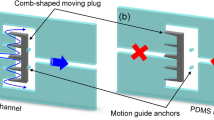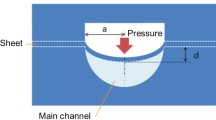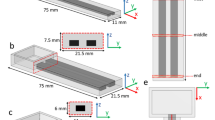Abstract
This paper details the behavior of capillary valves in centrifugal microfluidic devices prepared by three-dimensional (3D), or solid-object, printing. Microfluidic structures containing valve channels with different widths, heights, and radial distances from the center of rotation were studied and compared with extant capillary valve theories. Due to the printing process, the produced valve channels possessed a ridged or “scalloped” pattern. Hence, actual channel widths at the widest and narrowest points of the ridged pattern were determined, and used in comparisons between theoretical and empirical values. In addition, variations in contact angle resulting from the ridged pattern were measured and employed in theoretical calculations. For 1-mm high valve channels, the critical angular frequency (rpm) required to overcome capillary valve pressure was found to be independent of width. However, as the height of the valve channel was reduced, the critical rpm was found to become progressively more width-dependent increasing more rapidly for narrower channels. Both of these observations point to a role for feature sharpness, as well as the geometry of the valve channel opening, in valve behavior. Otherwise, valves followed a predictable trend of increasing critical rpm with decreased valve height and decreased radial distance from the rotation center. Using these results as a guide, then, it is possible to prepare centrifugal microfluidic devices by 3D printing with operability comparable to devices prepared by other microfabrication techniques.





Similar content being viewed by others
References
Badr IHA, Johnson RD, Madou MJ, Bachas LG (2002) Fluorescent ion-selective optode membranes incorporated onto a centrifugal microfluidic platform. Anal Chem 74:5569–5575
Chen JM, Huang P-C, Lin M-G (2008) Analysis and experiment of capillary valves for microfluidics on a rotating disk. Microfluid Nanofluid 4:427–437
Cho H, Kim H-Y, Kang JY, Kim TS (2007) How the capillary burst microvalve works. J Colloid Interface Sci 306:379–385
Cooper KG, Griffin MR (2003) Microgravity manufacturing via fused deposition. Technical Report NASA/TM-2003-212636, National Aeronautics and Space Administration, Marshall Space Flight Center, Alabama
Ducrée J, Haeberle S, Lutz S, Pausch S, von Stetten F, Zengerle R (2007) The centrifugal microfluidic bio-disk platform. J Micromech Microeng 17:S103–S115
Duffy DC, Gillis HL, Lin J, Sheppard NF Jr, Kellogg GJ (1999) Microfabricated centrifugal microfluidic systems: characterization and multiple enzymatic assays. Anal Chem 71:4669–4678
Gorkin R, Park J, Siegrist J, Amasia M, Lee BS, Park J-M, Kim J, Kim H, Madou M, Cho Y-K (2010) Centrifugal microfluidics for biomedical applications. Lab Chip 10:1758–1773
Huang TT, Chang W-J, Akin D, Gomez R, Bashir R, Mosier N, Ladisch MR (2003) Microfiber assisted fabrication of microfluidic channels using poly(dimethylsiloxane). AIChE J 49:2984–2987
Johnson RD, Badr IHA, Barrett G, Lai S, Lu Y, Madou MJ, Bachas LG (2001) Development of a fully integrated analysis system for ions based on ion-selective optodes and centrifugal microfluidics. Anal Chem 73:3940–3946
Johnson RD, Gavalas VG, Daunert S, Bachas LG (2008) Microfluidic ion-sensing devices. Anal Chim Acta 613:20–30
Khare K, Zhou J, Yang S (2009) Tunable open-channel microfluidics on soft poly(dimethylsiloxane) (PDMS) substrates with sinusoidal grooves. Langmuir 25:12794–12799
Kim J, Kido H, Rangel RH, Madou MJ (2008) Passive flow switching on valves on a centrifugal microfluidic platform. Sens Actuators B 128:613–621
Kisin S, Scaltro F, Malanowski P, van der Varst PGT, de With G (2007) Chemical and structural changes at the ABS polymer-copper metal interface. Polym Degrad Stab 92:605–610
Lee BS, Lee J-N, Park J-M, Lee J-G, Kim S, Cho Y-K, Ko C (2009) A fully automated immunoassay from whole blood on a disc. Lab Chip 9:1548–1555
Madou M, Zoval J, Jia G, Kido H, Kim J, Kim N (2006) Lab on a CD. Annu Rev Biomed Eng 8:601–628
Maher PS, Keatch RP, Donnelly K (2010) Characterisation of rapid prototyping techniques for studies in cell behavior. Rapid Prototyping J 16:116–123
Man PF, Mastrangelo CH, Burns MA, Burke DT (1998) Microfabricated capillary-driven stop valve and sample injector. In: Proceedings of 11th annual international workshop on micro electro mechanical systems, Heidelberg, pp 45–50
Mark D, Metz T, Haeberle S, Lutz S, Ducrée J, Zengerle R, von Stetten F (2009) Centrifugo-pneumatic valve for metering of highly wetting liquids on centrifugal microfluidic platforms. Lab Chip 9:3599–3603
Mark D, Haeberle S, Roth G, von Stetten F, Zengerle R (2010) Microfluidic lab-on-a-chip platforms: requirements, characteristics, and applications. Chem Soc Rev 39:1153–1182
McDonald JC, Chabinyc ML, Metallo SJ, Anderson JR, Stroock AD, Whitesides GM (2002) Prototyping of microfluidic devices in poly(dimethylsiloxane) using solid-object printing. Anal Chem 74:1537–1545
Moschou EA, Nicholson AD, Jia G, Zoval JV, Madou MJ, Bachas LG, Daunert S (2006) Integration of microcolumns and microfluidic fractionators on multitasking centrifugal microfluidic platforms for the analysis of biomolecules. Anal Bioanal Chem 385:596–605
Sundberg SO, Wittwer CT, Gao C, Gale BK (2010) Spinning disk platform for microfluidic digital polymerase chain reaction. Anal Chem 82:1546–1550
Weinand C, Gupta R, Weinberg E, Madisch I, Neville CM, Jupiter JB, Vacanti JP (2009) Toward regenerating a human thumb in situ. Tissue Eng Part A 15:1–11
Zeng J, Banerjee D, Deshpande M, Gilbert JR, Duffy DC, Kellogg GJ (2000a) Design analysis of capillary burst valves in centrifugal microfluidics. In: van den Berg A, Olthius W, Bergveld P (eds) Micro total analysis systems 2000. Kluwer Academic Publishers, Dordrecht, The Netherlands, pp 579–582
Zeng J, Greiner KB, Deshpande M, Gilbert JR (2000b) Fluid capacitance model of capillary-driven stop valves. ASME 2000 2:1–7
Acknowledgments
This work was funded by the National Aeronautics and Space Administration (NASA-KY EPSCoR; Research Infrastructure Development and Research Area Program). The authors thank Mark Crain of the University of Louisville Micro/NanoTechnology Center for his assistance with surface profiling, and Ramesh Utharala for software development in LabView. JLM would also like to thank Mr. Jesse D. Jones for his endowment of the Hattie Mayme Ross Graduate Scholarship at Murray State.
Author information
Authors and Affiliations
Corresponding author
Rights and permissions
About this article
Cite this article
Moore, J.L., McCuiston, A., Mittendorf, I. et al. Behavior of capillary valves in centrifugal microfluidic devices prepared by three-dimensional printing. Microfluid Nanofluid 10, 877–888 (2011). https://doi.org/10.1007/s10404-010-0721-1
Received:
Accepted:
Published:
Issue Date:
DOI: https://doi.org/10.1007/s10404-010-0721-1




